Greening the grey
DC green one US capital’s largest infrastructure projects
Amanda Rycerz, Will Bugler, Lydia Messling, and Georgina Wade, Acclimatise for Resilience Shift
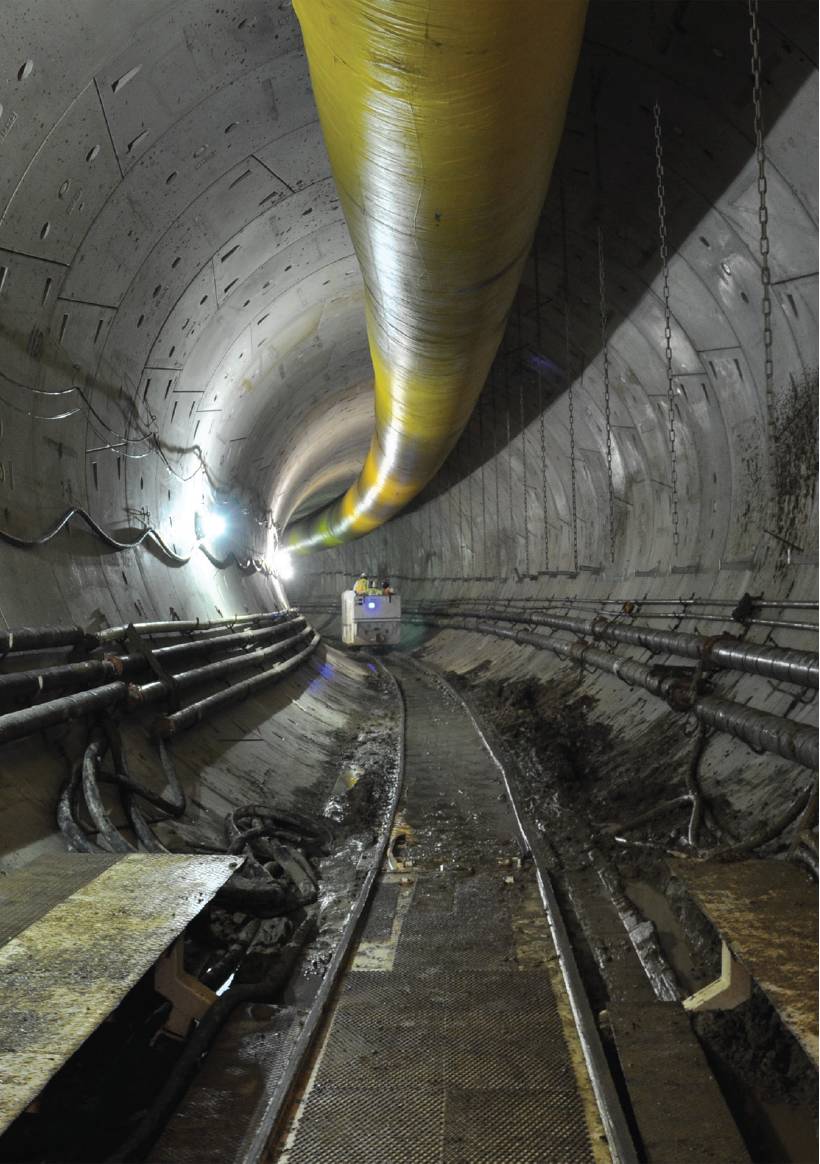 Upgrading Washington DC’s sewer system.
Upgrading Washington DC’s sewer system.IN 2015, the District of Columbia Water and Sewer Authority (DC Water) pressed pause on one of the largest infrastructure projects in the city’s history to incorporate a massive investment in green infrastructure.
Financed with the help of the world’s first environmental impact bond, the green infrastructure components fundamentally changed the $2.6bn plan to upgrade the US capital’s sewer system, replacing a considerable amount of the planned grey infrastructure whilst removing the equivalent stormwater, saving money on water rates, and delivering a host of other benefits including green jobs for DC residents. This is the story of how DC Water reaped the benefits of greening the grey.
In 2005, DC Water embarked on the biggest infrastructure project since the creation of the metro system. It began to plan a massive upgrade to the city’s sewer system to tackle a worsening sewer overflow problem.
Just a few years earlier, the district’s combined overflows reached such a high volume so frequently that they violated the US Clean Water Act. Stormwater from flooding exceeded the capacity of the sewers, polluting local waterways. Population growth and climate change meant that without action to build resilience, Washington DC’s sewage system would likely fail with increasing regularity.
In response, DC Water established a 20-year, $2.6bn long-term control plan – the Clean Rivers Project. The plan would manage the amount of sewer overflow polluting DC’s waterways by investing in wastewater infrastructure.
Initially DC Water intended to do this by building three separate large sewers with the aim of reducing sewer overage by 96%. However, the high capital expenditure costs would have driven up utility bills for ratepayers. Ten years later, in 2015, DC Water found a solution. It adjusted its plans to incorporate $100m worth of green infrastructure that reduced capital investment costs, while delivering the same amount of stormwater reduction benefits.
One of the major hurdles to the green infrastructure components was attracting finance for the project. To achieve its goal, DC Water had to deploy new thinking across the whole value chain from planning and implementation, to operations and maintenance.
One of the first major hurdles, for instance, was financing the green infrastructure elements of the project. At the time, green infrastructure was considered to carry greater investment risk, as there was some uncertainty over the exact amount of stormwater reduction that could be delivered, and there were few examples of large scale green infrastructure already in operation.
To overcome this, DC Water helped to create a new financial mechanism to fund the green infrastructure component. It created the world’s first environmental impact bond which released funds to enable green infrastructure to be built.
The resulting green infrastructure has been successful at managing stormwater flow and has also delivered numerous other benefits for the community, including improved streetscape, air quality improvements, street-level cooling and providing hundreds of green jobs, at least 51% of which are planned to be filled by district residents.
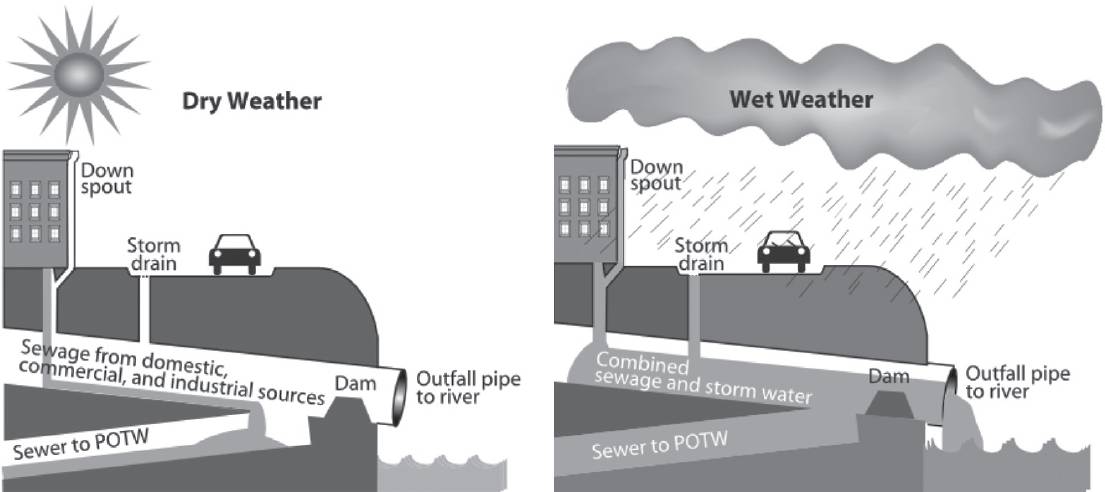
Combined sewer system. During dry weather (and small storms), all flows are handled by the publicly owned treatment works. During large storms, the relief structure allows some of the combined stormwater and sewage to be discharged untreated to an adjacent water body. Source: US Environmental Protection Agency, Washington, DC. Report to Congress: Impacts and Control of CSOs and SSOs.
Approximately a third of all of DC is served by single-piped combined sewers, the majority of which are located in the older and more developed parts of the city. DC’s sewer system was considered state-of-the-art when it was constructed in the 1870s, but today’s major capital investments require aging infrastructure to be modernised to account for the combined pressures of population growth and increased stormwater runoff from high-intensity rainfall events.
During dry periods the combined sewage and stormwater is treated at the Blue Plains water treatment facility in southwest DC before being released into the Potomac River. However, when it rains, the capacity of the combined sewer system is sometimes exceeded, causing a mix of stormwater and sewage to overflow and discharge into DC’s waterways at specific outfall points (Anacostia and Potomac Rivers, and Rock Creek and tributary waters). This discharge prevents the sewers from flooding the city’s streets with raw sewage.
An untenable situation
Each year roughly 2 billion gallons of combined stormwater and sewer overflow is released into the district’s rivers and tributaries. Increased urbanisation and more frequent and intense downpours have caused combined sewer overflow events to become increasingly common.
Legal action drives and long-term control plan
With Washington DC’s combined overflows discharging into the waterways with increasing frequency, pollution levels eventually violated the Clean Water Act and the terms and conditions specified under the National Pollutant Discharge Elimination System Permit. This led to a number of lawsuits being filed against DC Water by community and environmental organisations, and the US Environmental Protection Agency. Under the Clean Water Act, combined sewer overflows are regulated as point source pollution, and release into waterways requires special National Pollutant Discharge Elimination System Permits. These permits are granted under the condition that the entity (in this case DC Water) creates a long-term control plan to minimise the number of overflow events to a level compliant with water quality standards.
In March 2005, the parties agreed to a consent decree, which would mandate combined sewer overflow control activities and dates by which they needed to be implemented. The consent decree stipulated that green infrastructure was to be considered in the development of a detailed plan for combined sewer overflow management and that $3m was to be spent on pilot or demonstration projects to evaluate its effectiveness.
The past is not a prologue
The 2005 long-term control plan relied on historical rainfall records from 1988 to 1990 to develop goals for future combined sewer overage control. However, climate change projections for the mid-Atlantic point to heavier and more frequent rainfall events, meaning that sewer systems need to be able to accommodate future increases in stormwater runoff. A key challenge for infrastructure planners is to manage deep uncertainty created by both socio-economic changes and climate change.
As grey wastewater treatment infrastructure is a fixed asset with a life span of over 100 years, they must be designed with a view to the future, otherwise, the risk of failure is high. In 2008 the Environmental Protection Agency conducted a study in the New England and Great Lakes regions to examine whether long-term control plans for combined sewer overage management would be compliant under future climate change impact projections and if incremental design changes could support future storm water management goals.
The report found that long-term control plans based on current or past hydrological patterns (such as DC Water’s 2005 plan) may not be compliant in the future, due to variable rainfall projections. DC Water reviewed the DC Clean Rivers Project with national climate assessment projections to better understand potential future conditions. As a result, it added a 20% capacity margin above baseline projections to accommodate future climate change impacts.
The 2006 Federal Triangle Flood
In June 2006, the district experienced several days of heavy rain, the equivalent of a 200-year storm, which overwhelmed the sewer system and caused significant flooding of the Federal Triangle area. The flooding shut down federal agencies and the Smithsonian museums, inundating the 9th and 12th Street tunnels under the National Mall and flooding two metro stations. The flood cost millions of dollars in damages, demonstrating the costly impact of increasing flood severity and frequency.
Managing deep uncertainty
Washington DC is located at the confluence of two tidally-influenced rivers (the Potomac and Anacostia) and on the new underground Tiber Creek. This makes it especially vulnerable to flooding from extreme rainfall events. Since DC Water’s long-term control plan was conceived, the city has undertaken detailed climate change risk assessments and adaptation planning.
Building resilience in the face of uncertainty, necessitates close cooperation between different municipal departments, to ensure that governance does not become fragmented. Over 20 district government agency directors came together to determine how agencies can make the city more sustainable while advancing their core missions. Together these groups developed the city’s sustainability plan, Sustainable DC, in 2013. As a direct result of the plan, the city developed a strategy to adapt to the changing climate, called Climate Ready DC.
By identifying the impacts that a changing climate will have on the district, risks to infrastructure, public facilities and neighbourhoods can be more efficiently counteracted. As the first step of a multiphase project led by the Department of Energy and Environment, a vulnerability and risk assessment and adaptation plan were prepared to analyse projections and scenarios for the district, and present adaptation options. This work emphasised the importance of taking action to ensure that the city’s critical infrastructure is able to cope with a climate that looks significantly different to today’s. For example, a 1-in-100-year storm in DC today is expected to become a 1-in-25-year event by mid-century — four times more likely — and a 1-in-15-year storm by the 2080s.
Relating to increasing resilience of drinking water, wastewater, and stormwater systems the adaptation plan recommended that the city should increase combined sewer and separate stormwater system capacity with green and grey infrastructure including raingardens, green roofs, trees, cisterns, and pervious pavement.
The first Sustainable DC plan focused on climate and environment as a major challenge and documented ongoing holistic solutions, such as the green infrastructure being used by DC Water. The plan also proposed additional solutions to climate and community issues that could be found in natural systems and water management, setting targets goals and actions to increase the use of green infrastructure.
Paying for the long-term control plan
With approval from the Environmental Protection Agency, the goal of the Clean Rivers Project was to reduce combined sewer overage by 96% by investing in grey infrastructure projects, including the construction of three large tunnels beneath in the Anacostia, Potomac, and Rock Creek watersheds. These tunnels would capture sewer overage during heavy rains and transport it to the Blue Plains advanced wastewater treatment facility. The project was expected to cost $2.6bn, which would make it one of the most expensive tunnel projects in the US, and when finished it would be the largest public works project in the nation’s capital since the metro system was built 50 years earlier.
Whilst the proposed plan would have been able to manage combined sewer overflows, paying for the Clean Rivers Project would prove challenging. Capital improvements are funded by ratepayers through a monthly charge added to their bills. When DC Water first introduced the charge in 2009, it set an unsustainably low rate that has dramatically increased over the past decade. The fee rose from $1.24/month per 1,000 square feet in 2009, to $25.18/month in 2018. The charge has proven particularly expensive for churches, not-for-profits and low-income communities that cannot afford the high and rising costs of their bills.
This model allows DC Water to recoup some of its investment if the green infrastructure performs badly and, in turn, investors are compensated if the green infrastructure performs better than anticipated.
Finding ways to improve the financial sustainability of the Clean Rivers Project and reduce the burden on ratepayers while managing future stormwater events would require new thinking. Green infrastructure investments such as rain gardens, green roofs, and permeable pavements are often cheaper than building and maintaining grey infrastructure, and have the potential to be highly effective in reducing the volume of stormwater entering the drainage systems in the first place, thereby reducing the likelihood of overflow events. From a project financing perspective, one considerable challenge for green infrastructure is that it is much harder to calculate the exact amount of stormwater that green infrastructure will manage in practice, in comparison to the more certain capacity calculations used for the equivalent grey infrastructure.
The big question for DC Water was; what if it doesn’t work? The efficacy of green infrastructure as a large-scale solution was still untested. Compared to grey infrastructure, it was harder to predict whether green infrastructure would be successful. DC Water therefore needed a way to reduce the financial risk, keep costs to a minimum, and maximise the potential benefits. A standard municipal bond would not go far enough, therefore a new type of bond was needed. To achieve this DC Water created the world’s first environmental impact bond.
In September 2016, DC Water issued the environmental impact bond to finance the first phase of green infrastructure construction under the Clean Rivers Project. The bond reflects key elements of a payfor- success model – a performance-based contract between public and private entities where payment is based on measurable performance outcomes. This model allows DC Water to recoup some of its investment if the green infrastructure performs badly (risk share payment) and, in turn, investors are compensated if the green infrastructure performs better than anticipated (outcome payment). As managing stormwater flows with green infrastructure is considered riskier than grey infrastructure, this model offered DC Water a financial hedge if it turned out to be not as successful as planned
It was a 30-year, $25m tax-exempt municipal bond with an initial 3.43% interest coupon paid twice per year for the first five years. The bond proceeds pay for the upfront costs to construct green infrastructure in the Rock Creek Sewer Shed (Project-A). If the first phase was successful, the bond would provide a replicable and scalable approach for green infrastructure finance in other contexts.
 Pay for success
Pay for successAt the five-year mandatory tender date (1 April 2021) following a performance evaluation, the contingent payment may be required from DC Water to the investors or vice-versa. If the green infrastructure performs better than expected at reducing stormwater runoff (a reduction of greater than 41.3%), DC Water would make an outcome payment to the investors of $3.3m. If the green infrastructure underperforms at reducing runoff (less than 18.6%), the investors would make a one-time risk share payment to DC Water of the equivalent amount. If performance falls within the expected outcome range, neither party would receive a payment.
As the environmental impact bond is based on measurable outcomes, the project requires pre and post evaluations. Prior to green infrastructure implementation, the project partners measured baseline levels of stormwater runoff in Rock Creek over a 12-month period to assess performance ranges for expected runoff reduction. After the green infrastructure is implemented project partners will conduct 12-months of post-monitoring and assessment to evaluate the effectiveness of the measures in Rock Creek Project-A, measured by the percentage reduction in stormwater runoff.
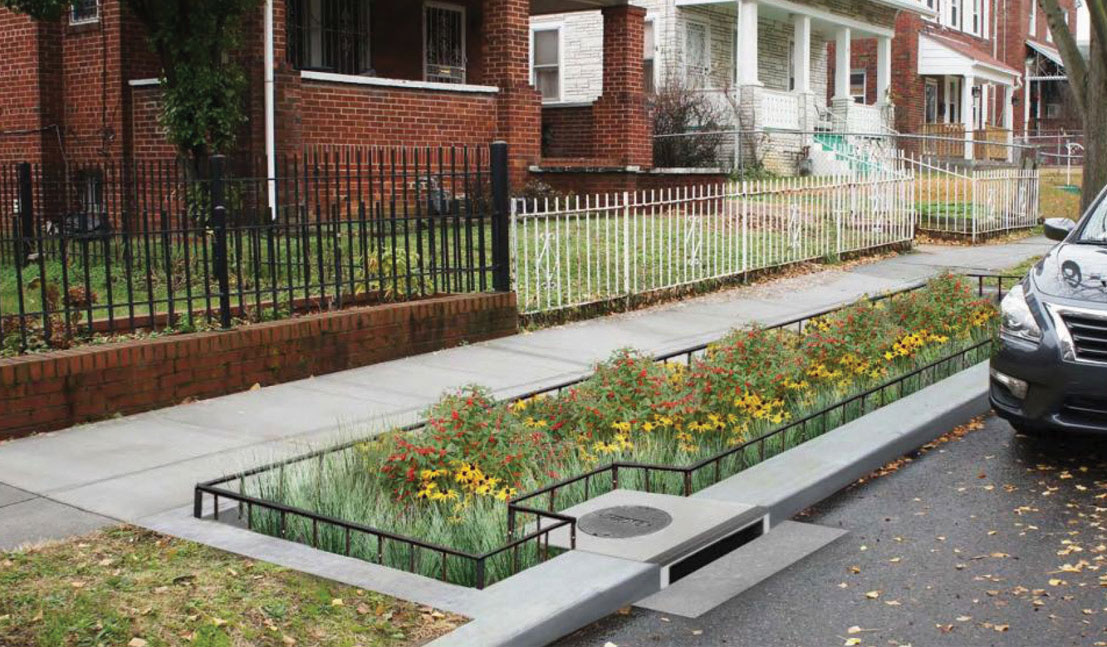 A bio-retention planter and semi-permeable pavement design.
|
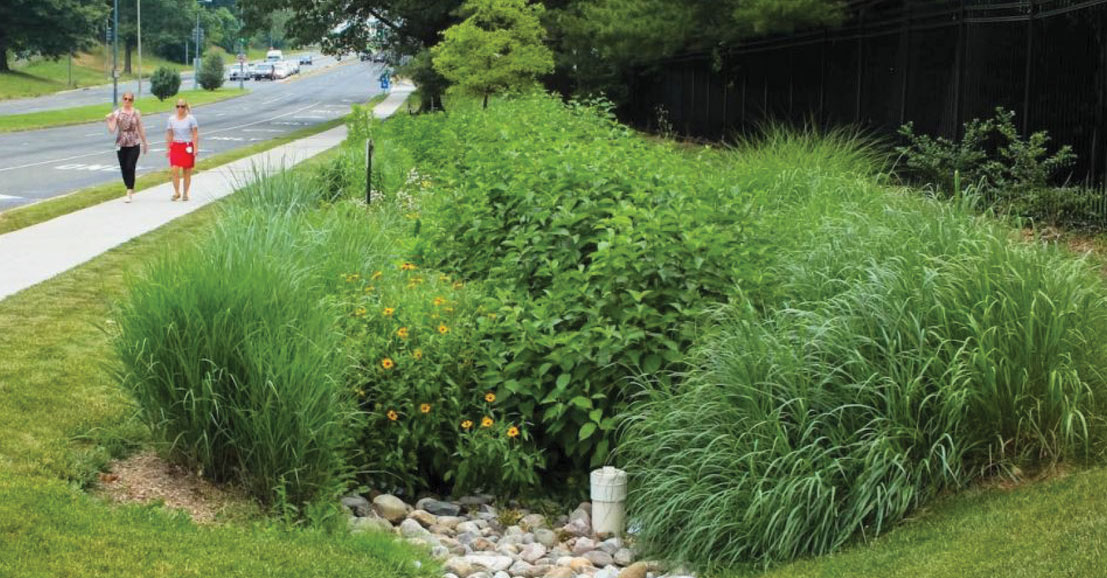 Bioswale created alongside streets at the Irving Street Green Infrastructure Project, Washington DC. Credit: DC Water
|
Greening the grey
A 2008 study by the Environmental Protection Agency quantified the contribution that a range of green infrastructure practices could make towards reducing stormwater runoff, and volumes and frequencies of overflows into the district’s rivers. The measures modelled in the study included rain gardens, rain barrels, green roofs, street-side bioretention planters, tree cover, permeable pavement and green verges. The study showed that the measures could reduce average yearly stormwater runoff by 26.3%, making a substantial contribution to combined sewer overflow reduction
In 2016, DC Water produced a new plan that took on board the recommendations of the study and adopted new technology to help build resilience. The new plan integrated green infrastructure, reducing the project’s reliance on tunnel construction. Under it the Anacostia Tunnel would proceed as planned, but the Rock Creek Tunnel would be replaced by green infrastructure, and green infrastructure investments would compensate for a shorter Potomac River Tunnel.
DC Water’s revised approach to the long-term control plan culminated in the Green Rivers Project. The decision to integrate green infrastructure into the project required an appreciation of fresh evidence about new technologies (in this case green infrastructure technology); a systems approach to understanding DC’s flooding problems (to intercept the water at a different point in the watershed); and an outcomes-led approach of infrastructure itself (conceptualising infrastructure by the services it delivers rather than its physical form)
In Rock Creek, green infrastructure would be designed to retain 1.2 inches of rainfall runoff from 365 acres of impervious surfaces in order to reduce or eliminate the need for a storage tunnel to control the Piney Brach CSO outflow. In the Potomac River sewershed, green infrastructure would be used in three drainage areas to manage the runoff produced by 1.2 inches of rain falling on 133 impervious acres.
The modified Potomac Tunnel would have a storage capacity of 30 million gallons (versus the 58 million gallons originally planned) to manage overflows from four outfall areas, instead of the entire sewershed, and it no longer needed a large pumping station as it could be configured to drain by gravity into the Blue Plains Tunnel. The project has been extended by five years to 2030 to allow for more affordable and technically feasible implementation schedules. Under this extended timeline and the optimising of investments, rate payers are expected to see an average reduction in annual bills from $1,675 to $1,200.19.
Rock Creek Project-A
Rock Creek Project-A, the first phase of the Clean Rivers Project, is intended to manage the volume associated with 1.2 inches of rain, falling on 365 impervious acres of land. Green infrastructure construction activities began in the summer of 2017 and were completed over the next two years in a phased approach to minimise community disruption. From 2019 to 2020, green infrastructure performance was monitored and assessed to see how effective they were at meeting stormwater reduction targets. Techniques include:
- Permeable pavement includes porous asphalt, pervious concrete or permeable interlocking pavers that allow rainwater to permeate through and infiltrate the soils below.
- Rain gardens/bio-retention include planter boxes or on-the-ground vegetated basins that absorb runoff from streets, sidewalks and parking lots and slowly drain excess water.
- Downspout disconnection is where property owners re-route rooftop drainage pipes to drain into rain barrels or previous surfaces (such as lawn or vegetated basin) rather than into storm sewers. The campaign ‘Drain the Rain’ incentivised property owners to disconnect their downspouts in exchange for a rain barrel.
Potomac River Project A
The second major green infrastructure works takes place on the Potomac River. This involves the construction of bioretention (rain gardens) in planter strips and permeable pavement on streets and alleys.
Added value
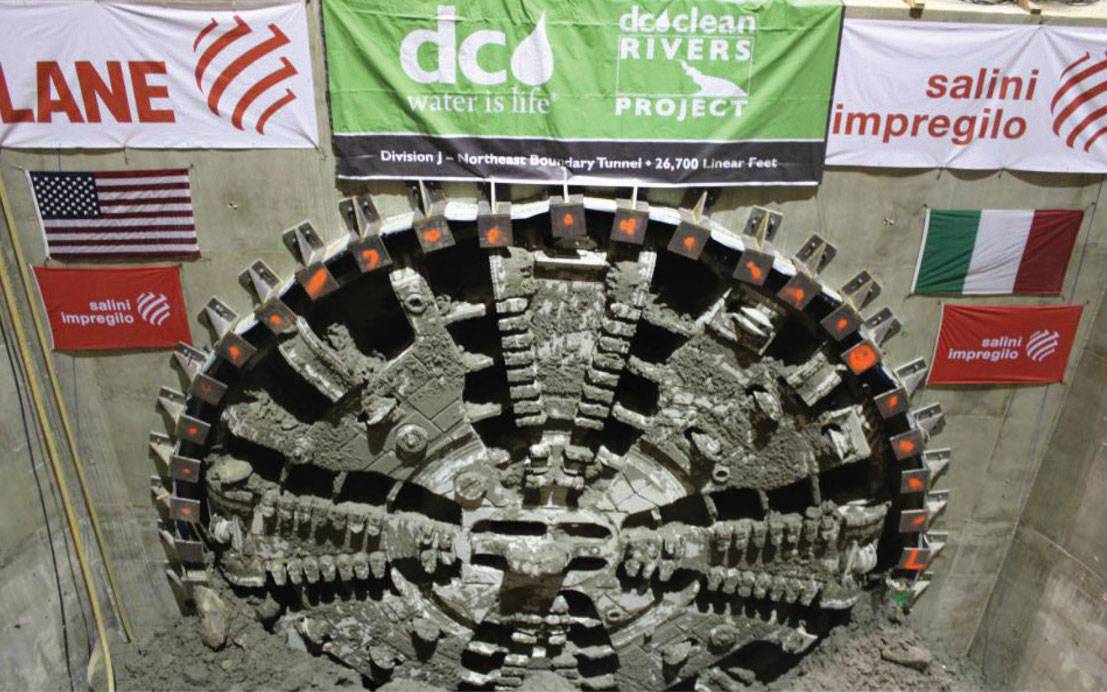 DC Water's tunnel boring machine, Chris, reaching the W Street shaft in the mining of the Northeast Boundary Tunnel on the Anacostia River.
DC Water's tunnel boring machine, Chris, reaching the W Street shaft in the mining of the Northeast Boundary Tunnel on the Anacostia River.
Credit: DC Water
The construction work for the grey and green infrastructure is well underway. On the Anacostia River, the first portion of the tunnelling is operational, having been completed in March 2018. The full length of tunnelling is due to be completed by 2023 on the Anacostia River. The National Park Service has also recently completed an environmental assessment and approved DC Water’s proposal to move forward with construction of the Potomac River Tunnel.
To date, the portion of the Anacostia River Tunnel that is in service has prevented more than 7 billion gallons of combined sewage and 3,500 tons of refuse from entering the Anacostia. When the entire 13.1-mile tunnel, is completed, it will reduce combined sewer overflows to that river by 98%. The Potomac River Tunnel is expected to reduce the volume of sewer overflows by 93%, and the frequency of overflow events from approximately 74 to four events in a year of average rainfall.
The recently installed green infrastructure components of the plan are being monitored to see whether they are delivering the expected reduced stormwater flow rates. However due to the relatively straightforward nature of the green infrastructure construction, DC Water was able to complete the projects quickly, delivering immediate benefits to DC residents. Whilst the grey infrastructure components of the scheme manage the stormwater discharge effectively, their benefit is limited to this specific task. The green infrastructure delivers a range of additional co-benefits, including local job creation, improved air quality, cooler ambient temperature, increased property values, greenhouse gas mitigation, habitat for wildlife species and recreational and amenity value.
Regulating DC’s temperature, for example, is an important function as the urban heat island effect is expected to intensify with climate change. As well as demonstrating the benefits of resilience in practice, the application of green infrastructure shows the value of applied systems thinking. DC water was able to manage stormwater flows effectively, by assessing the potential for measures that prevent water moving to the drains – a fundamentally different part of the system than the sewers themselves.
The job creation opportunities from the maintenance of the green infrastructure components was a major selling point for the scheme, convincing local government and the community of its benefits. DC Water established an ambitious local jobs programme that includes training and certification opportunities for district residents interested in green infrastructure construction, inspection and maintenance jobs through the National Green Infrastructure Certification Programme.
The green jobs created are different to those required for the operation and maintenance of grey infrastructure. Instead of tunnel maintenance being carried out on a relatively infrequent basis by a team of specialist contractors, the green infrastructure requires regular maintenance by employees with basic training. This provides steady employment that is accessible to a much larger section of the DC community. This allowed DC Water to establish a goal to have 51% of new jobs created by the green infrastructure project to be filled by district residents.
The green infrastructure component also increases the overall resilience of the city to unexpected changes in the types of shocks and stresses that it will face in the future. The green infrastructure lends the overall project greater adaptive capacity. If the project is underperforming, modifications can be made, for example by planting more flood-tolerant species, to reach performance targets. It can also be relatively easily scaled up to accommodate future precipitation. By contrast, grey wastewater treatment infrastructure is designed to reach pre-defined thresholds and is fixed in the short and medium-term – making it difficult to adjust without major additional capital expenditure.
DC Water will continue to monitor the performance of the green infrastructure components, however early indications suggest that the scheme has been successful in delivering its primary function of reducing combined sewer overflow, cutting capital expenditure on grey infrastructure, building the resilience of the project to unexpected shocks and stresses, creating jobs, and delivering a host of other co-benefits to an improved urban environment for DC residents.
Amanda Rycerz, Will Bugler, Lydia Messling, and Georgina Wade, Acclimatise for Resilience Shift www.resilienceshift.org @resilienceshift
This article is adapted from Rycerz R, Bugler W, Messling L and Wade G (2020) Greening the grey: Why DC Water put green infrastructure at the heart of one of the US capital’s largest infrastructure projects. Resilience Shift
---
1 There are approximately 860 cities in the US with combined sewer systems, mostly located in the Northeast and Great Lakes region
